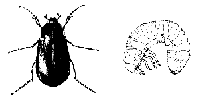White Grubs
Phyllophaga spp.
Biology
White grubs in the genus Phyllophaga are also
known as "perennial" white grubs or "true" white grubs. Several common
species occur in Illinois. Adults are the large May and June beetles
that range in length from to 1 inch and vary in color from tan to dark
brown.

White grub adult and larva.
Adults of common species range from 1/2 to
1 inch (12 - 25 mm) in length;
C-shaped larva may exceed 1 inch in length
Damage
Females deposit eggs in soil during late spring or
early summer; they especially prefer grass sod near wooded areas for
egg-laying. As a consequence, damage caused by larvae is greatest in
crops grown on sites that were grass-covered the previous season.
Newly-hatched larvae feed on crop roots throughout the summer, then
burrow deep in the soil to overwinter. The following year they again
migrate to the root zone to feed. These larger larvae cause much greater
damage than they did the year before. After overwintering again well
below the soil surface, white grubs pupate early in the following
summer, and adults emerge from pupal cells in the spring three years
after the cycle began.
Control
Because very few strawberry plantings are now
placed on ground that was used for sod, pasture, or grass set-aside the
previous year, white grubs are not common in Illinois strawberries. For a
list of insecticides that might be used for grub control in
strawberries, see the up-to-date edition of the Illinois Commercial Small Fruit and Grape Spray Guide. Banding insecticides over the row reduces the amount and cost of insecticide treatment.